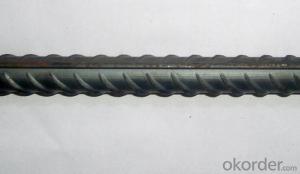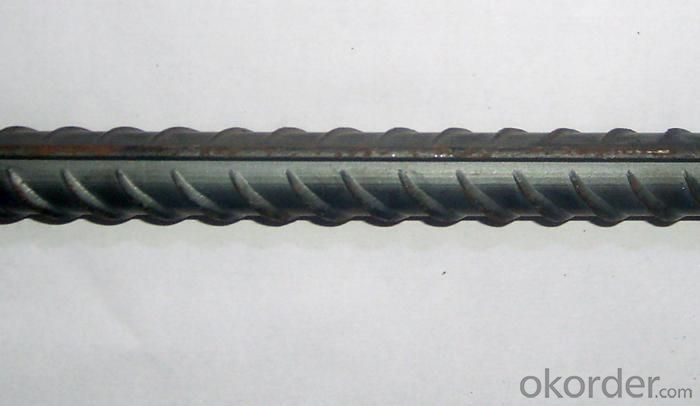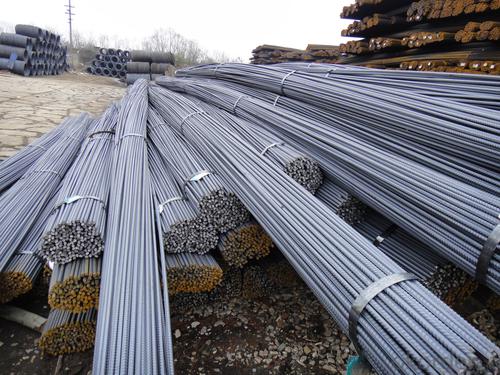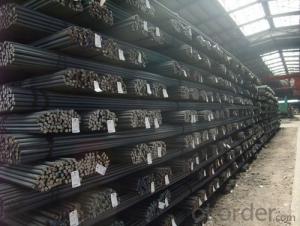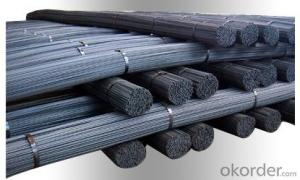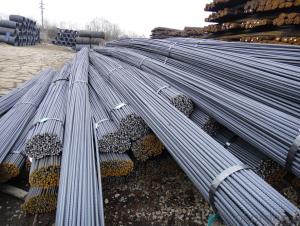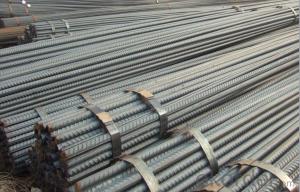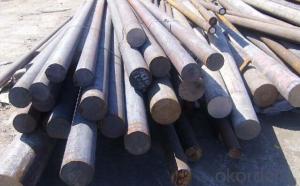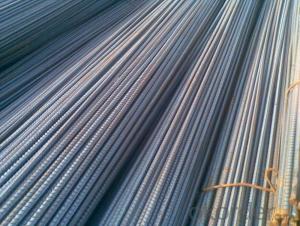Hot Rolled Carbon Steel Rebar 32mm with High Quality
- Loading Port:
- China Main Port
- Payment Terms:
- TT or LC
- Min Order Qty:
- 25 m.t.
- Supply Capability:
- 10000 m.t./month
OKorder Service Pledge
OKorder Financial Service
You Might Also Like
Product Description:
OKorder is offering Hot Rolled Carbon Steel Rebar 32mm with High Quality at great prices with worldwide shipping. Our supplier is a world-class manufacturer of steel, with our products utilized the world over. OKorder annually supplies products to European, North American and Asian markets. We provide quotations within 24 hours of receiving an inquiry and guarantee competitive prices.
Product Applications:
Hot Rolled Carbon Steel Rebar 32mm with High Quality is widely used in buildings, bridges, roads and other engineering construction. Big to highways, railways, bridges, culverts, tunnels, public facilities such as flood control, dam, small to housing construction, beam, column, wall and the foundation of the plate, deformed bar is an integral structure material. With the development of world economy and the vigorous development of infrastructure construction, real estate, the demand for deformed bar will be larger and larger..
Product Advantages:
OKorder's Hot Rolled Carbon Steel Rebar 32mm with High Quality are durable, strong.packed and suitable for construction
Main Product Features:
· Premium quality
· Prompt delivery & seaworthy packing (30 days after receiving deposit)
· Can be recycled and reused
· Mill test certification
· Professional Service
· Competitive pricing
Product Specifications:
Manufacture: Hot rolled
Grade: HRB335 HRB400 BS4449 Grade460 ASTM Grade40 Grade60
Certificates: ISO, SGS, BV, CIQ
Length:6m 8m 9m 12m
Packaging: Export packing, packed by coil
FAQ:
Q1: Why buy Materials & Equipment from OKorder.com?
A1: All products offered byOKorder.com are carefully selected from China's most reliable manufacturing enterprises. Through its ISO certifications, OKorder.com adheres to the highest standards and a commitment to supply chain safety and customer satisfaction.
Q2: How do we guarantee the quality of our products?
A2: We have established an advanced quality management system which conducts strict quality tests at every step, from raw materials to the final product. At the same time, we provide extensive follow-up service assurances as required.
Q3: How soon can we receive the product after purchase?
A3: Within three days of placing an order, we will begin production. The specific shipping date is dependent upon international and government factors, but is typically 7 to 10 workdays.
Q4: How many tons per bundle?
A4: Around 2-3tons
Q5: How to avoid the rust after deliver the goods to the loading port?
A5: We will keep the goods at the port covered with water-proof material
Q6: What is the chemical composition and physical properties of HRB400?
A6:
Grade | Technical data of the original chemical composition (%) | ||||||
C | Mn | Si | S | P | V | ||
HRB400 | ≤0.25 | ≤1.60 | ≤0.80 | ≤0.045 | ≤0.045 | 0.04-0.12 | |
Physical capability | |||||||
Yield Strength (N/cm²) | Tensile Strength (N/cm²) | Elongation (%) | |||||
≥400 | ≥570 | ≥14 | |||||
Images:
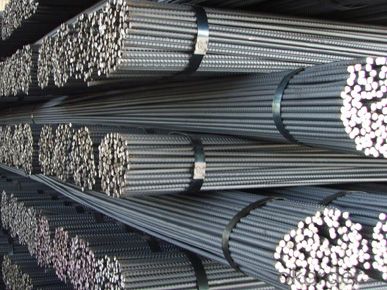
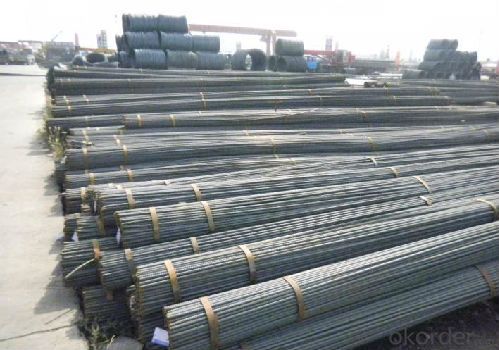
- Q: Are steel rebars suitable for use in structures with high resistance to chemicals?
- Steel rebars are generally not suitable for use in structures with high resistance to chemicals. While steel is a strong and durable material, it is susceptible to corrosion when exposed to certain chemicals. Chemicals such as acids, alkalis, and chlorides can cause steel rebars to corrode, which can compromise the structural integrity of the building or structure. To ensure high resistance to chemicals, alternative materials such as stainless steel rebars or fiber-reinforced polymer (FRP) rebars are often used. Stainless steel rebars are more resistant to corrosion than regular steel rebars due to their higher chromium content. FRP rebars, on the other hand, are non-metallic and do not corrode, making them a suitable choice for structures exposed to harsh chemical environments. Ultimately, the choice of rebars in structures with high resistance to chemicals depends on the specific chemicals involved and the level of exposure. It is important to consult with engineers and experts who can assess the chemical environment and recommend the most suitable rebars to ensure the long-term durability and safety of the structure.
- Q: Are there any health or safety concerns associated with steel rebars?
- Yes, there are potential health and safety concerns associated with steel rebars. These concerns primarily arise during the handling, installation, and cutting of rebars. The sharp edges of rebars can cause cuts and injuries if not handled properly. Additionally, the heavy weight of rebars can lead to musculoskeletal strains and injuries if workers do not use proper lifting techniques. Furthermore, the process of cutting or bending rebars generates steel dust, which, if inhaled, can be harmful to the respiratory system. Thus, it is essential to follow safety guidelines and use appropriate protective equipment to mitigate these risks.
- Q: How are steel rebars protected during transportation and storage?
- Steel rebars are protected during transportation and storage through various measures such as stacking them on pallets or racks to prevent contact with the ground, using protective coverings or tarps to shield them from moisture and environmental elements, and securing them with straps or bands to prevent shifting or damage.
- Q: How do steel rebars affect the structural capacity of concrete beams and columns?
- The role of steel rebars in enhancing the structural capacity of concrete beams and columns cannot be overstated. These rebars serve as reinforcement, providing added strength and durability to the concrete elements. When steel rebars are incorporated into the concrete, the load-bearing capacity of the beams and columns is significantly increased. One of the main functions of steel rebars is to counteract the tensile forces that concrete alone cannot withstand. Concrete is strong under compression but weak under tension, which makes it prone to cracking and failure when subjected to tensile stress. By integrating steel rebars into the concrete, the tensile strength of the reinforced element is greatly improved. The steel rebars act as a framework within the concrete, distributing the load more evenly and reducing the risk of localized failure. When external loads or forces are applied, the rebars bear the tensile stress while the concrete maintains its compressive strength. This combination of materials creates a reinforced concrete element that can handle heavier loads, thus increasing the structural capacity of the beams and columns. Moreover, steel rebars also enhance the ductility and flexibility of the concrete elements. This means that the reinforced beams and columns can undergo greater deformations before reaching failure. The ability to deform without breaking is particularly important in regions prone to earthquakes, as it allows the structure to absorb and dissipate energy, thereby minimizing the risk of collapse. Additionally, steel rebars improve the resistance of concrete beams and columns against shrinkage and thermal stresses. Concrete tends to shrink as it cures and expand and contract due to temperature variations. The presence of steel rebars helps minimize these effects by providing a reinforcing network that restrains the concrete from excessive movements, preventing cracks and preserving the overall structural integrity. In conclusion, steel rebars have a profound impact on the structural capacity of concrete beams and columns. They enhance tensile strength, improve ductility, reduce shrinkage and thermal stresses, and increase overall load-bearing capacity. The combination of concrete and steel reinforcement produces a significantly stronger and more durable structural element that can withstand higher loads, ensuring the stability and safety of the entire structure.
- Q: What is the maximum spacing allowed between steel rebars in a concrete structure?
- The maximum spacing allowed between steel rebars in a concrete structure depends on various factors such as the size and strength of the rebars, the design requirements, and the intended use of the structure. However, a general guideline is that the spacing between rebars should not exceed three times the diameter of the largest bar being used. This ensures proper reinforcement and structural integrity of the concrete.
- Q: Are there any safety concerns related to handling steel rebars?
- Yes, there are safety concerns related to handling steel rebars. Some of the potential hazards include cuts and punctures from sharp edges, strains and sprains from lifting heavy rebars, and potential injuries from falling rebars if they are not properly secured. It is important to wear appropriate personal protective equipment, use proper lifting techniques, and ensure secure storage and handling to minimize the risks associated with steel rebars.
- Q: Are there any limitations on the length of steel rebars?
- There are limitations on the length of steel rebars, which are typically set by industry standards and guidelines. These limitations are mainly determined by practical and logistical factors. One limitation is related to transportation and handling of rebars. Steel rebars are typically manufactured in long lengths, often up to 60 feet (18 meters) or more. However, due to the weight and stiffness of steel rebars, it becomes challenging to transport and maneuver such long lengths. Therefore, rebars are often cut into shorter lengths for ease of transportation and handling on construction sites. Another limitation is related to the structural integrity of the rebars. Longer rebars may be more prone to bending, warping, or sagging, which can compromise their effectiveness in reinforcing concrete structures. To ensure structural integrity, rebars are often limited to specific lengths based on the specific application and design requirements. Additionally, there may be limitations imposed by local building codes and regulations. These codes and regulations aim to ensure the safety and durability of structures. They may specify the maximum length of steel rebars that can be used in different construction applications to meet the required standards and ensure the structural integrity of the building. In summary, while steel rebars can be manufactured in long lengths, practical considerations, structural integrity, and local regulations often impose limitations on their length. These limitations are in place to ensure the efficient handling and transportation of rebars, maintain their structural integrity, and comply with building codes and regulations.
- Q: What is the role of steel rebars in the construction of retaining walls?
- Steel rebars play a crucial role in the construction of retaining walls as they provide strength and reinforcement to the concrete structure. They help to distribute and resist the lateral pressure exerted by the soil, ensuring the stability and durability of the wall.
- Q: Can steel rebars be used in tunneling and mining operations?
- Yes, steel rebars can be used in tunneling and mining operations. Rebars, which are steel bars commonly used to reinforce concrete structures, can also be employed in underground construction projects such as tunnels and mines. These steel bars provide additional strength and stability to the structures in these environments, ensuring durability and safety. In tunneling projects, rebars are often embedded in shotcrete or concrete linings to enhance the structural integrity of the tunnel walls and prevent collapse. Similarly, in mining operations, rebars are used to reinforce the roofs, walls, and support structures within the mine, safeguarding against potential hazards such as rockfalls and cave-ins. The use of steel rebars in tunneling and mining operations is crucial for maintaining the integrity and stability of these underground structures.
- Q: What are the guidelines for the proper anchoring of steel rebars in walls?
- To ensure the structural integrity and stability of the construction, it is crucial to properly anchor steel rebars in walls. Here are some guidelines to adhere to for the correct anchoring of steel rebars in walls: 1. Determine the necessary rebar size and spacing: The design specifications and load requirements dictate the size and spacing of rebars. Consult a structural engineer or refer to building codes for the appropriate rebar size and spacing. 2. Clean and prepare the concrete surfaces: Prior to anchoring the rebars, ensure that the concrete surfaces are clean and devoid of dust, debris, and loose material. Utilize a wire brush or compressed air to eliminate any contaminants. 3. Employ appropriate anchoring techniques: The most widely used method for anchoring steel rebars in walls is embedding them into the concrete. Ensure secure embedding by following these steps: a. Drill holes: Drill holes in the concrete wall at designated locations and depths, ensuring the hole diameter matches the rebar size. b. Clean the drilled holes: Utilize compressed air or a brush to remove any dust or debris from the drilled holes. c. Insert rebars: Insert the rebars into the drilled holes, making sure they reach the required embedment depth. d. Maintain proper spacing: Follow design requirements to maintain the specified spacing between rebars. e. Secure rebars: Use suitable anchoring materials like epoxy resin or grout to secure the rebars in place. Adhere to the manufacturer's instructions for mixing and applying the anchoring material. f. Verify proper alignment: Before the anchoring material sets, ensure the rebars are correctly aligned both horizontally and vertically. 4. Allow sufficient curing time: After anchoring the rebars, allow ample time for the anchoring material to cure. This guarantees that the rebars are firmly secured in place. 5. Adequately protect the rebars: Once the rebars are anchored, protect them from corrosion by applying a suitable corrosion-resistant coating or by using corrosion-resistant rebars. It is imperative to adhere to these guidelines, as improper anchoring of steel rebars can compromise the structural integrity of the walls and pose safety risks. Always consult a qualified structural engineer or building professional for specific guidelines tailored to your project.
Send your message to us
Hot Rolled Carbon Steel Rebar 32mm with High Quality
- Loading Port:
- China Main Port
- Payment Terms:
- TT or LC
- Min Order Qty:
- 25 m.t.
- Supply Capability:
- 10000 m.t./month
OKorder Service Pledge
OKorder Financial Service
Similar products
Hot products
Hot Searches
Related keywords
